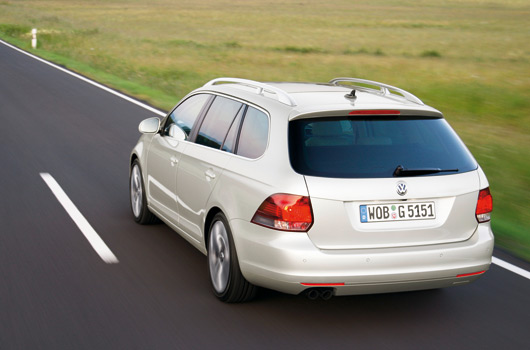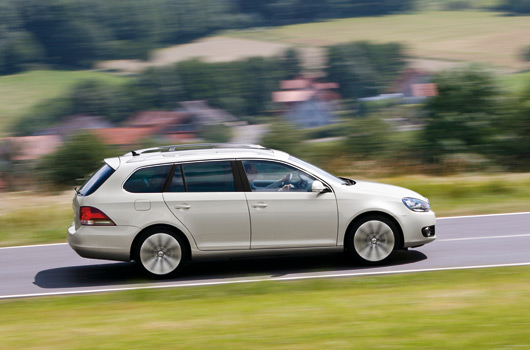Volkswagen Australia will be launching the Golf Variant next year. Expected to arrive by March 2010 the car will be marketed here as the Golf Wagon, dropping the usual Variant label used in overseas markets.
The front end is, pretty much, all regular Golf. The back end, is all new, of course, and while the side profile is quite smart, the rear detailing is not so successful. The rear tail light assembly, in particular, is a bit ugly, quite frankly. Still, practicality is the order of the day here, and such details probably won’t bother too many potential customers.
Pricing hasn’t been confirmed, however, Volkswagen Australia Managing Director, Anke Koeckler, has indicated it will be “several thousand dollars” more than the volume selling Golf hatch. Currently, entry level pricing for the Mk6 Golf begins at around $26,000 for a 1.4 TSI or a shade over $33,000 for a 2.0 TDI. It is probably safe to expect engine options will match closely to those announced when the Mk6 Golf was launched in February this year.
So, this wagon won’t be the cheapest kid on the block. But with up to 1550 litres of storage space on offer Volkswagen will be hoping it’s mix of fuel efficient engines, renowned build quality and mid-premium status will attract young families, and possibly even some fleet sales, to the Golf Wagon.
A European press release, and a variety of images follow after the jump.
UPDATE: Here’s a quick review from Autocar.
[Source: Sydney Morning Herald]
To the Point: Estate Car – The Golf as Space Wonder
- Estate with climate control and daytime running lights starts at € 18,500
- Front end of Golf Estate now follows new Volkswagen “Design DNAâ€
Wolfsburg, 28 September 2009 – In the sixth generation of the world bestseller, this is the fourth body version to be launched after the three- and five-door Golf and the latest Golf Plus. The Estate is one of the most successful models on the market, particularly in the company car market.
The extensive redesign of this Estate should ensure that the all-around talent further extends its position as a business estate car and as a first car for families as well. The base price of the new Golf Estate in Germany is € 18,500, which includes ESP, six airbags, daytime running lights, roof railing, electric windows all around, upshift indicator, electrically adjustable and heated outside mirrors, 1/3 to 2/3 split folding rear bench seat and backrest, central locking with RF remote, climate control, 16-inch wheels and up to 1,550 litres of cargo capacity.
The front end of the Golf Estate was completely redesigned. Its visual appearance follows today’s Volkswagen “Design DNAâ€. From now on, its appearance will be defined by clear horizontal lines and bold headlight styling. Key engines of the Golf three- and five-door models were also transferred to the Estate. In the interior, high-end instruments of the current Golf set the tone.
Features and engines
At its market launch, the successful Estate (more than 95,000 new vehicle registrations in 2008) will be offered in the three equipment versions Trendline, Comfortline and HighÂline. The latter replaces the previous Sportline version as the top equipment line. Engines that can be ordered at the start of sales are four petrol engines with a power range from 59 kW / 80 PS and 118 kW / 160 PS and two diesels. The very quiet common rail turbo-diesels (TDI) output 77 kW / 105 PS and 103 kW / 140 PS. The 105-PS TDI may be ordered as a BlueMotionTechnology version. In this case, the already low combined fuel consumption of 4.5 litres fuel per 100 kilometres (equivalent to 119 g/km CO2) is reduced to 4.2 litres (109 g/km CO2).
Exterior
In front, the new Golf Estate is recognised by its modified bumper and radiator grille, new engine bonnet styling and redesigned fenders and headlights; all were transferred 1:1 from the Estate’s three-door and five-door counterparts. In contrast to the previous model, the front-end design is no longer defined by a chrome radiator grille, but instead by a black, horizontal layout of the grille and front bumper painted in body colour. The Estate has an additional large air intake in the lower front section as well. Starting with the mid-level equipment version (Comfortline), chrome inserts are integrated in the radiator grille and the lower air intake. In the top Highline version, this also applies to the surrounds for the front fog lights with new static turning light function, which are a standard feature here.
At the rear, the independent design of the previous model has been upgraded in the new generation by modified taillights with a higher-end appearance and bumpers whose lower area is also fully painted in body colour. From now on, TDI and TSI versions can also be recognised by their tailpipes, which are no longer covered by the bumper. In addition, Volkswagen developed a new range of wheels for the new Golf Estate.
Interior
At the time of its presentation last autumn, the sixth generation Golf received excellent marks, especially for its high-end quality. In the interior, it was especially in the styling of the instruments and gauges where the Golf crossed boundaries to the next higher class and still does. The same instruments, including a standard multi-function display and upshift indicator, are now being used in the new Golf Estate too. Also adopted from the Golf is the new generation of three-spoke steering wheels.
All controls for the new Golf climate control system were integrated in the Golf Estate as well. Volkswagen also adapted its line of different seat covers to the entire model series (Trendline: “Roxyâ€; Comfortline: “Scoutâ€; Highline: Alcantara/fabric “Merlinâ€). Also transferred were the radio and navigation systems including the interfaces for MP3 players and Bluetooth mobile telephones. Two driver assistance systems are available as options for the first time in the Golf Estate: “Park Assist†(automatic parking assistant) and “Rear Assist†(rearview camera). Another optional feature is the panoramic sunroof that is popular among many Golf Estate buyers.
Euro-5 engines of the new Golf Estate
Volkswagen is launching the new Golf Estate on the market with four petrol and two diesel engine options; they all meet the emission limits of the new Euro-5 standard. The entry level continues to be marked by an 80-PS petrol engine, followed by a 102-PS version. The two most powerful petrol engines (TSI with 122 PS and 160 PS) and the two common rail turbo-diesels (TDI with 105 PS and 140 PS) may be ordered with the optional Direct Shift Gearbox (DSG) as an automatic transmission.
Diesel engines
Like the larger 2.0-litre TDI, the 1.6-litre TDI is also characterised by noticeably quiet noise levels, low emissions (119 g/km CO2) and an extremely low combined fuel consumption value (4.5 litres per hundred kilometres). Compared to the previous model of the same power, fuel consumption was reduced by 0.7 litre. The 140 PS strong and 210 km/h fast Golf Estate 2.0 TDI consumes 5.0 litres per 100 kilometres (132 g/km CO2), which is impressively low considering its power. The TDI engines may be ordered on the Comfortline or Highline.
Petrol engines
As already noted, the petrol engines of the Golf Estate have power levels of 80 PS (MPI), 102 PS (MPI), 122 PS (TSI) and 160 PS (TSI). The base engine with 80 PS is available in the Trendline equipment line; the 102-PS version may be ordered as a Golf Estate Trendline or Golf Estate Comfortline.
Just how efficiently the current petrol engines from Volkswagen perform is well-illustrated by the TSI offered on the Golf Estate Comfortline and Highline. The 6.3 litre (122 PS) and 6.4 litre (160 PS) fuel consumption values of the TSI engines place their combined fuel consumption on par with the already economical base engine with 80 PS. When shifted by DSG, fuel consumption is even reduced to 6.0 litres per 100 kilometres (139 g/km CO2) on the 122-PS TSI and 6.1 litres (143 g/km CO2) on the 160-PS version. This range of engines makes the new Golf Estate one of the most economical and cleanest estate cars in Europe.




















7 replies on “Volkswagen’s Golf joins Estate bandwagon”
[…] be launched, including, the new Golf GTI (October 2009), a revised Transporter T5 (early 2010), new Golf Wagon (March 2010), new Polo (by June 2010), the eagerly awaited Golf R (June 2010) and in late 201o […]
After looking at the pics, not surprised to see the ‘U’ word in your notes.
And thats from someone who loves golfs.
Still, probably not as bad as some of Subarus recent efforts.
Wouldn’t make more sense to be a Jetta wagon like it is in the US??? With the same engine choices/equipment levels? Hmmmm….
I think I’d prefer an Octavia Combi to this. Quite easily in fact – the Octavia Combi isn’t ugly! 😀
@amrjon – Yeah, I’m a big fan of Golfs too, but that rear end is disastrous. A shame, too, especially as the Passat wagon, in contrast, is a very good design solution.
Why would you bother with that ugly Golf when you can buy that Skoda RS?
Why would you bother with either, no auto-tailgate.
[…] Australia have just released an Estate version to their volume selling Golf range. Known in Australia as the Golf Wagon, it will be initially […]